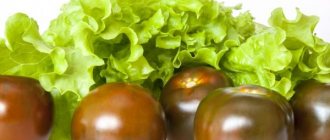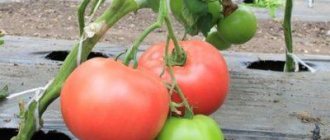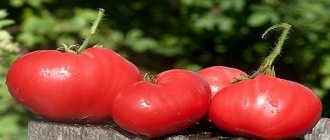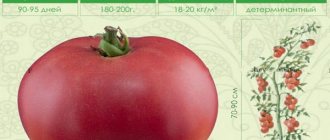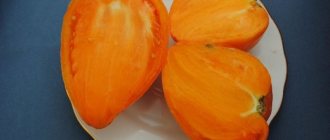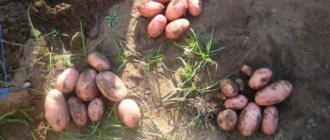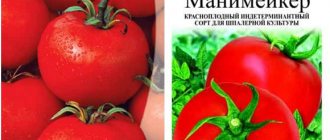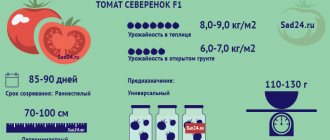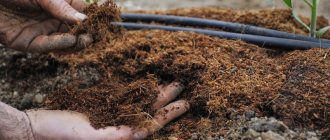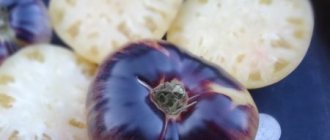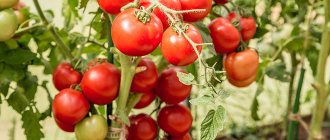The Cinderella tomato meets all the requirements of summer residents for this crop. The variety easily tolerates the vagaries of weather and annually pleases with high yields.
| Height | Landing location | Ripening time | Fruit color | Fruit size | Origin | Fruit shape |
| short | Open ground | Early ripening | Reds | Average | Variety | Round |
Description and characteristics of the variety
The cultivar was registered in 2002, the originator is the Federal Scientific Center for Vegetable Growing, Moscow Region. Cinderella is recommended for summer cottages, personal plots and small farms. The variety is intended for cultivation in open ground, for salad purposes and for home canning.
The plant belongs to the category of early ripening determinate - the stem height is only 50 cm. 100-108 days pass from germination to ripening.
The plates are large, the inflorescences are simple, there are few shoots and leaves on the stem. Inflorescences are laid on the stem very often, sometimes even without separation by a leaf.
The fruits of the variety are spherical, smooth, glossy. An unripe tomato develops a dark green spot near the stalk. The color of the ripe fruit is from scarlet to dark red. There are at least 4 nests in a tomato, the average weight is 140 g. The tasting rating of the tomatoes is good.
Advantages and disadvantages
This variety has both virtues and negative sides.
- He gets sick very little.
- The type is early ripening.
- Quite resistant to adverse weather conditions.
- The bushes are compact and do not need to be tied up.
- By growing tomatoes of this variety, you can independently stock up on seeds for next year.
- The fruits ripen before (time and almost simultaneously.
- Compared to other southern varieties, the yield of the considered uninhabited (= sparsely populated) variety is very high.
- The fruiting period for Cinderella tomatoes is quite laconic.
For the conditions of the middle zone, this variety is excellent. Such tomatoes can be grown both in the garden and in garden beds.
Features of cultivation and storage
Caring for seedlings and plants in open ground is standard. Seedlings are planted in a permanent place when they form their first flower cluster. Overgrown specimens can be planted obliquely.
The variety does not need staking, despite the looseness of the bush. Low stems and quickly filling fruits, even when on the ground, do not have time to suffer from soil infections. If you don’t have enough time, you don’t have to root the tomato, but when you remove the axillary shoots, the fruits will be larger.
When ripe, tomatoes can be stored for about 10 days.
Propagation of edible honeysuckle Cinderella
Reproduction of edible honeysuckle is possible both by seed and vegetative methods. Healthy seedlings can be obtained from seeds, but there is no guarantee that they will retain varietal characteristics. Therefore, gardeners propagate Cinderella honeysuckle vegetatively - by layering or cuttings.
Green cuttings give the highest percentage of rooting
The most effective method of propagation is green cuttings. When using them, approximately half of the planting material takes root. The best time for cuttings is the period of fruit ripening. The procedure is as follows:
- A branch of annual growth 20-40 cm long must be torn off from the mother branch with a piece of cambium (heel).
- Place the cuttings in a root formation stimulator (heteroauxin) for 12-16 hours.
- Plant the cuttings at an angle of 45° towards the sun in a special bed. A mixture of peat and perlite is used as a nutrient soil. The location for the bed should provide shade for the cuttings at midday and light in the morning.
- Regularly moisten the bed with cuttings. After 2-3 weeks, the shoot will begin to form its own root system.
Important! In the first winter, young seedlings must be insulated, since their root system is superficial and vulnerable. For this you can use spruce branches, fallen leaves, straw
Reproduction scheme for honeysuckle Cinderella by layering
Another simple way to propagate Cinderella honeysuckle is to create air layering. To do this, a strongly inclined side shoot is fixed to the ground and dug in. In the process of regular moistening, roots and independent shoots will begin to form in the internodes of the shoot. The cuttings overwinter together with the mother bush, and in the spring they can be cut off from the parent branch and transplanted to another place.
Fruit characteristics
Let's begin the description of the fruits with the fact that they are streamlined in shape, smooth to the touch, and when ripe they acquire a pronounced red color.
Usually they are removed from the bush in a ripe form for fresh sampling, for slicing into a vegetable salad. And closer to autumn, these vegetables are prepared for canning.
When you cut a tomato, you can see 3-4 chambers inside, filled with pulp, juice and seeds, the chambers are separated by thick partitions.
The characteristics would be incomplete without this information: the fruits perfectly withstand long-term transportation in transport, the main thing is to carefully place them in boxes.
Diseases and pests
- Fusarium or fusarium wilt is characterized by the death of the edges of the leaf blade and petioles. As the disease progresses, the leaves turn brown and dry out.
- Phytophthora—the development of the bush slows down, the leaves become gray-green and bend upward. The next stage in the development of this disease is the death of strawberry roots.
Important! Fusarium and late blight can be prevented if, before planting a new plantation, the roots of the planting material are dipped in a solution of the drug “Potassium Humate” (15 g of substance per 1 liter of water), after which the roots of the same seedlings are dipped in a solution of the drug “Agatha” (1 l of water takes 7 g of substance).
- Gray rot on berries is visible to the naked eye; the entire crop is covered with a gray fluffy coating of developing mycelium. The berries become unsuitable for food.
- Brown and white spotting appears on strawberry leaves as brown or white spots on the leaf. As soon as signs of the disease are noticed by the gardener, the plantation must be treated with special preparations against these diseases. If this is not done, then within a week the disease will spread to the entire berry patch.
The insect world also readily parasitizes sweet strawberry plantings.
You can fight insects that harm plants using chemical treatments with special preparations or biologically pure herbal infusions. Modern
Any gardening center will offer a large selection.
Did you know? Garden strawberries are highly valued by residents of many countries. The Belgians created a museum in honor of this berry, which is located in the city of Vepion in Belgium.
There is also a folk remedy for controlling insects on strawberries.
- one bucket of fresh wormwood is filled with boiling water to the top and left to steep for a day. Before use, the infusion is filtered through cheesecloth, and one spoon of finely grated laundry soap is added to it (for better adhesion). You need to spray the berry plantation with wormwood infusion in the morning.
To prevent outbreaks of fungal diseases, gardeners are not recommended to grow strawberries in one place for more than 4 seasons. During this time, plants take from the soil all the beneficial substances necessary for this particular crop, and the soil itself is populated by viruses and insect pests.
The most successful option is to have four beds of strawberries: every autumn, one bed of a four-year-old crop is uprooted and destroyed. Then plant a new bed with healthy planting material and in a new location. This is how, with diligence and diligence, you can plant remontant strawberries “Cinderella” on your plot and treat your children and grandchildren with a sweet and aromatic berry in the summer and wonderful strawberry jam in the winter.
Was this article helpful?
Thank you for your opinion!
Write in the comments what questions you have not received an answer to, we will definitely respond!
You can recommend this article to your friends!
You can recommend this article to your friends!
Yes
No
Already helped 37 times
The main problems of these tomatoes:
- late blight;
- aphid;
- Colorado beetle;
- whitefly
As a preventative measure, the bushes must be treated with specialized compounds to protect tomatoes from late blight.
Productivity
To grow a bountiful harvest of vegetables in the short northern summer, careful selection of varieties is required. The early-ripening Cinderella tomato is perfect for this.
The variety will please gardeners in the southern regions with fruits in open ground; in northern latitudes, in order to obtain maximum yield, it is still advisable to take care of placing it in a greenhouse or greenhouse for cultivation.
The first fruits can be harvested within three months after germination.
The yield of the Cinderella tomato reaches 8 kilograms per square meter, the fruits grow red, spherical in shape, weighing up to 150 grams, they are perfect for fresh consumption and canning.
Growing and care
To obtain a bountiful harvest, tomatoes are grown in seedlings.
Sowing begins at the end of March. Seeds are soaked for six hours in a solution of humate fertilizers to increase germination and saturate them with microelements. “Gumat 7” or “Prompter” are good for this.
The soil for young seedlings is prepared in advance in the fall, mixing 1/3 peat, 1/3 humus and 1/3 garden soil. To the resulting mixture add ½ liter of wood ash and two tablespoons of superphosphate per 10 liters of soil.
You can grow tomato seedlings in any containers that have holes in the bottom for drainage. Before filling the soil, the containers are thoroughly washed and soaked for three hours in a solution of potassium permanganate for disinfection.
Important: To prevent diseases of seedlings from the soil, soil is taken from cucumber or cabbage beds.
As soon as the young seedlings have a second true leaf, the seedlings are picked and planted in larger containers.
Two weeks before planting in a permanent place, the seedlings begin to harden off. To do this, she is taken out into a room with a temperature of 15 degrees every day for several hours.
The length of daylight hours is very important for seedlings. To grow high-quality, strong seedlings, you need to provide 12-14 hours of daylight. The best lamps for illumination are fluorescent, LED or halogen. In addition to light, ordinary incandescent lamps also emit a lot of heat, which affects the tops of plants.
During cultivation, it is recommended to feed the seedlings with a universal fertilizer every ten days. To do this, take ½ cup of ash and chicken droppings per 10 liters of water. All this is thoroughly stirred and left for a day.
READ MORE: Raspberry Patricia - description of the variety, photos, reviews
Tomatoes are planted in a permanent growing location 30-40 days after emergence. By this time, young seedlings can be 20-30 centimeters high.
Planting scheme for tomatoes of the Cinderella variety - 50 by 40 centimeters. For better survival, plants are planted in the evening and covered from the scorching rays of the sun for several days. To prevent young seedlings from freezing during the first nights after transplantation, they are additionally covered in the greenhouse with a second layer of film or spunbond.
Note: For overgrown and elongated seedlings, holes are dug of a larger diameter, the stem of the plant is carefully placed in the hole, leaving 30 cm on the soil surface, the rest is buried with earth. The buried part of the stem in the soil will produce additional roots.
Water the plants as the soil dries out with water at a temperature of 20-25 degrees Celsius. Watering is carried out at the root of the plant.
The optimal temperature for growing tomatoes is 20-25 degrees Celsius during the day, 15 degrees at night. At higher temperatures, as well as at high humidity, plant growth stops and they are affected by a variety of putrefactive diseases.
Plants of this variety are hung from top to bottom with numerous fruits. Up to 15 pieces ripen on each brush. Exact yield figures are not given anywhere, but those who plant this variety will work non-stop harvesting tomatoes. Perhaps this is why the cultivar received such a name - its fruits are enough for both the summer resident himself and for treating his neighbors.
Rules for planting and sowing
Seeds should be sown at the end of May so that when the seedlings are moved into the ground, the soil is already warmed up. Be sure to water the soil before planting. Seeds should be planted in wooden boxes and sprinkled with a special soil composition.
We suggest you familiarize yourself with: Tomato sowing and seedling care
Next, the containers are covered with film and placed in a warm place. When the first sprouts appear, the container should be placed on the windowsill so that the plants receive sunlight. If there is not enough daylight, it is necessary to organize additional lighting with a lamp. Seedlings need to be watered and loosened, fed with various fertilizers. After the second leaf appears, pick them into cups.
Short description
Recommended for early harvest in greenhouses and open beds.
Tomatoes of this variety are good for adding to salads and for pickling. Alyoshka is an early ripening tomato variety: it will take about 95 days to harvest. The plant is determinate, about 120 cm high. The bushes are quite powerful, tall, and definitely need to be tied to a support. The leaves are large and green. The peduncle has an articulation. The fruit is round, bright red in color, and weighs 250 grams. The tomatoes are very juicy and tasty. The yield in greenhouse conditions is 14 kilograms per square meter. This variety was developed recently, but many gardeners have already appreciated the quality of the tomatoes. Reviews of the Alyoshka F1 tomato say that the fruits are best consumed fresh.
Care
The quality of tomatoes depends on proper care. Reisetomate responds well to watering, loosening the soil and fertilizing. If you follow the recommendations, the yield can be increased.
- watering. Tomatoes are watered approximately 1-2 times a week. If the soil dries out quickly, then the rate can be increased up to 3-4 times every 7 days. After watering, mulch is laid in the form of straw and sawdust. It will help the roots endure drought and protect against hypothermia at night;
- loosening. The soil must be loosened after moistening. You can take a rake or loosen the soil with your hands. Roots need oxygen for full development;
- fertilizing The first fertilizing is carried out with nitrogen fertilizers. A tablespoon of ammonium nitrate is diluted in a bucket of water and watered under the bush 2-3 weeks after transplantation. The second feeding is carried out before and during flowering. A tablespoon of potassium sulfate is mixed with 10-15 g of superphosphate and 10 liters of water are added. Water the seedlings at the roots. This kind of nutrition is quite enough for tomatoes; you shouldn’t feed the plants more than 3-4 times a season.
Attention! Water and feed tomatoes in the first half of the day. Evening watering is not advisable
You need to harvest every 3-5 days. First, ripe tomatoes are picked, but before the cold weather, green fruits must also be collected. Reisetomate can be used to collect seeds; the grains retain their seed quality for 3-5 years.
